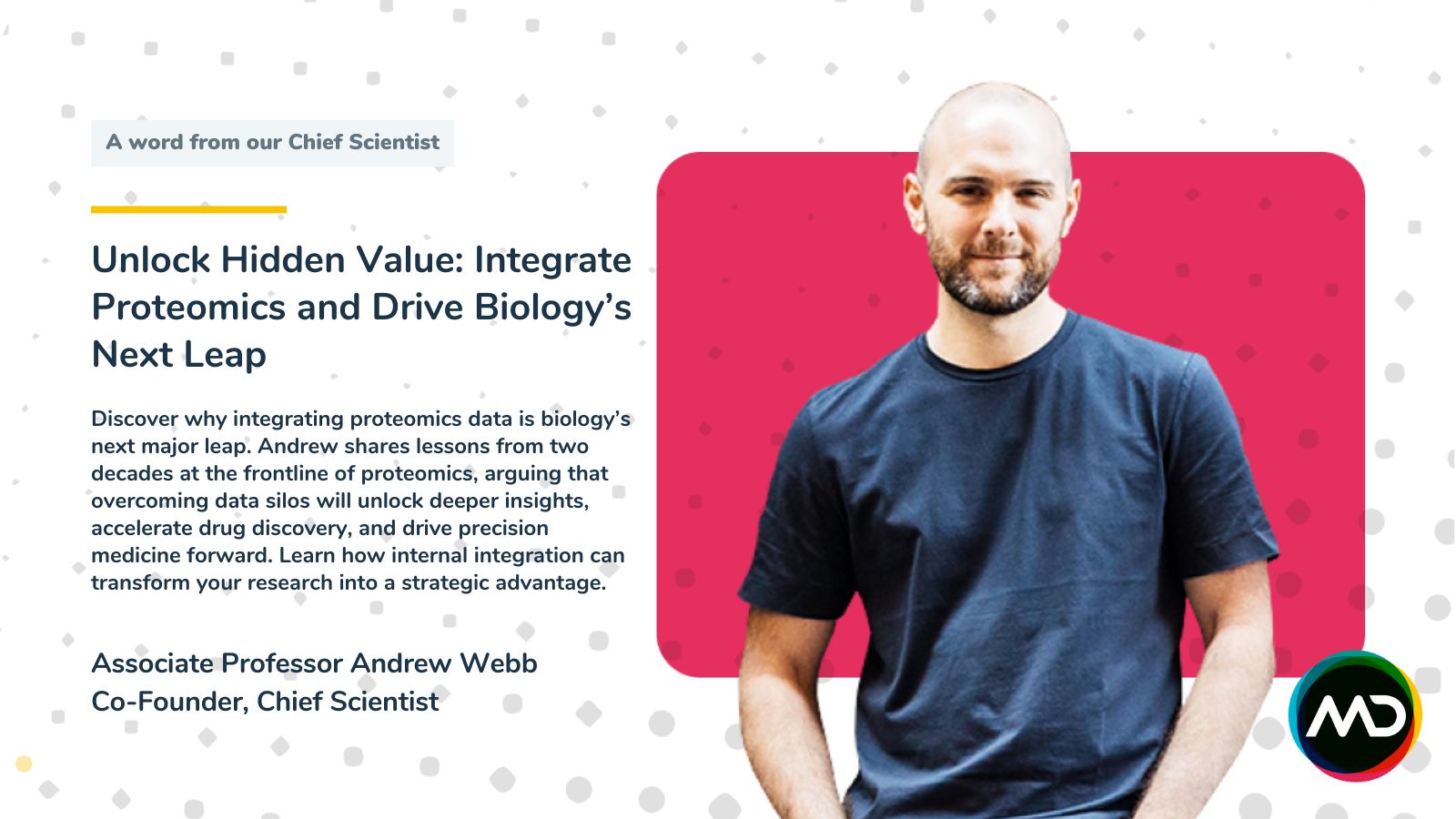
I’ve spent nearly two decades navigating the tsunami of data - first as an academic proteomics lead, now as a founder building platforms to tame it. The line that stays taped above my desk -
“We are drowning in information, while starving for wisdom. The world henceforth will be run by synthesizers, people able to put together the right information at the right time, think critically about it, and make important choices wisely.”
- E. O. Wilson, The Diversity of Life (1992)
Wilson’s quote could not be more relevant today. If we were drowning then, today we’re thrashing in a rising sea of data - frantically building boats without clear maps or navigational plans. I still vividly recall the profound realization from a small-scale phosphoproteomics study in our lab: the immense depth and detail captured in even one modest experiment hinted at insights we could scarcely imagine, making the thought of integrating multiple, well-designed datasets incredibly compelling. To truly turn data into wisdom, proteomics must escape isolation by integrating diverse datasets to reveal biology’s hidden complexity.
Proteomics at a Critical Threshold
Proteomics - the large-scale, quantitative study of proteins - has reached a critical threshold, driven by advances in mass spectrometry and high-throughput techniques. We're now sequencing entire proteomes in mere minutes, and labs worldwide are generating an explosion of proteomics data, with the public repository PRIDE alone ingesting over 700 newly published datasets monthly. Moreover, we see high-throughput proteomics increasingly integral in leading biotech companies, systematically mapping drug responses at the full proteome scale and becoming indispensable decision-making tools within contemporary drug pipelines.
Yet, for all this rich information, much of proteomics’ potential remains locked in isolated silos. Individual studies stand alone, their data often incomplete or poorly annotated. Each study is a pixel containing clues to life's complexity but loosely connected to biology’s broader picture. Proteomics today exemplifies Wilson’s paradox: massive data generation but fragmented insights. To reveal the biological “big picture,” we must integrate and properly position these pixels. Here, I argue why unifying proteomics data represents biology’s next transformative leap and outline a vision to unlock its hidden value.
Data-Rich and Fragmented – The High Cost of Isolation
Today’s proteomics experiments produce intricate snapshots capturing quantitative shifts in protein abundance and qualitative changes, such as phosphorylation, across diverse physiological and pathological contexts. Modern techniques approach comprehensive proteome coverage, yet each dataset, considered alone, tells only a fraction of the biological story.
Consider Alexander Fleming’s 1928 discovery of penicillin. Fleming noticed mold inhibiting bacterial growth, but isolated in his laboratory, this insight remained overlooked. Only when Howard Florey and Ernst Chain recognized the therapeutic potential in 1939 did penicillin become the miracle drug we know today. Fleming’s story resonates because I've encountered similar scenarios in proteomics - datasets clearly containing novel insights yet remaining isolated and unnoticed due to a lack of effective collaboration or integration. Each month of fragmentation delays life-saving insights and wastes millions in duplicated experiments.
The transformative potential of integrated proteomics is clear. During my post-doc training among immuno-oncology groups, I witnessed firsthand the powerful impact of cross-disciplinary collaboration. I observed how a single integrated proteomic-immune dataset significantly accelerated target validation efforts and even flagged potential off-pathway toxicities that might otherwise have remained unnoticed. Consider the historical separation of oncology and immunology, fields advanced separately by specialized funding, journals, and training. The deliberate integration of these disciplines - illustrated powerfully by immune checkpoint inhibitors (Topalian et al., 2012, NEJM) - unlocked adaptive, personalized cancer therapies. Similarly, systematic integration of proteomics datasets across disciplines promises richer, deeper insights than isolated studies alone.
Isolation also fosters redundancy, consuming resources as teams unknowingly duplicate work. Without standardized practices, inconsistent formats, and inadequate metadata undermine reproducibility and validation. In contrast, systematic integration promotes clarity, completeness, consistency, and significantly enhances scientific rigor and trustworthiness. Integration also amplifies predictive power, essential for precision medicine and biomarker identification, enabling advanced computational models. Clearly, dismantling these silos is urgent to unlock proteomics’ hidden value.
Success in proteomics integration, for me, means a future where researchers globally have seamless public access, while organizations fully maximize data internally, enabling dynamic collaboration across cross-functional teams. A PhD student in Nairobi should instantly be able to pull integrated tumor phosphosite data from labs in Melbourne, Bristol, and Boston, effortlessly adding her insights without wasting weeks on data formatting. Such accessibility and ease would profoundly accelerate discoveries and democratize impactful research.
Genomes, Galaxies, and Climate: Data Integration Has Changed Everything - Is Proteomics Next?
Scientific history demonstrates integration ignites revolutions in discovery. Data integration practically combines datasets - via standardized formats, common identifiers, and FAIR (Findable, Accessible, Interoperable, Reusable) metadata - to uncover novel insights.
- Genomics: Initially isolated, genomics research transformed with the Human Genome Project (2001 draft, 2003 completion). Later, the 1000 Genomes Project integrated diverse population data, identifying over 88 million genetic variants (Nature, 2015; doi:10.1038/nature15393), dramatically accelerating biological discoveries.
- Astronomy: Astronomers once relied on isolated telescopes. In April 2019, the Event Horizon Telescope integrated approximately 5 petabytes of data from eight global observatories, producing the first-ever image of the supermassive black hole in galaxy M87 - transforming scattered observations into groundbreaking cosmic discoveries.
- Climate Science: Initial isolated climate measurements (satellites, ocean buoys, weather stations, ice cores) integrated into comprehensive models greatly improved predictions. The IPCC's AR6 assessment (2021–2023), synthesizing over 14,000 studies, provided reliable global climate insights, informing policy effectively.
- Structural Biology: Structural biologists deposited around 300,000 high-quality protein structures in the Protein Data Bank (PDB) by 2020. This critical mass became the training data for AlphaFold and other AI models, yielding reliable predictions for over 200 million proteins. Integration turned decades of experimental effort into a universal atlas of molecular shapes.
Reality Check: Proteomics Repositories vs. Enterprise-Scale Integration
Despite valuable efforts by repositories like PRIDE, MassIVE, and ProteomeXchange, reuse rates for raw proteomics data remain below 5%, with over 40% of datasets missing key metadata. In my view, this is not merely an unfortunate statistic - it represents an urgent call to action. Consider what collective value you're missing from your research. How many years are you personally wasting by neglecting metadata hygiene? Public-scale integration remains elusive, hindered by inconsistent formats, incomplete metadata, minimal professional recognition for meticulous data curation, and IP concerns. Addressing these issues now will create templates within organizations that set the foundation for a global, interoperable proteome commons.
Yet, internal integration within organizations is both feasible and highly beneficial. Companies or consortia can enforce standardized workflows, harmonized ontologies, and secure access, fostering immense intellectual property creation. Each integrated experiment enriches internal knowledge graphs, enhancing AI-driven models and accelerating discovery cycles.
Integration ROI Inside Organizations:
- 10× faster target-validation cycles (pharma case studies)
- Secure retention of proprietary MS workflows
- Multi-omic fusion without public-data latency
From Promise to Practice: The Realistic Path Forward
Integrated proteomics promises:
- Holistic insights
- Built-in reproducibility
- AI-driven hypotheses
- Precision medicine advances
We've observed modern proteomics teams in biotech companies increase their analysis speeds of complex proteomics datasets by more than an order of magnitude by integrating these core principles, clearly demonstrating the practical benefits and efficiency gains of internal data integration.
A Pragmatic Vision for Integrated Proteomics
R&D leaders must treat proteomics integration as a strategic asset. By standardizing workflows, deploying secure platforms, and fostering collaboration, organizations won’t merely keep pace - they’ll set benchmarks for Digitised Biology and accelerate scientific discovery. I believe these strategic priorities should be considered:
Comprehensive Data Harmonization
- Mapping, standardizing, and enriching identifiers to ensure seamless integration across diverse proteomics datasets.
Flexible, Scalable, and Secure Infrastructure
- Providing dynamic computational environments that scale effortlessly while maintaining robust security to facilitate frictionless analysis and collaboration.
Culture and Systems for Maximizing Data Value
- Actively encouraging and rewarding the reuse and collaborative analysis of data through both technology-enabled metrics and organizational incentives.
Bringing this vision to life will require collective action across the scientific community. I'd love to hear what you believe are the most important strategic priorities to unlock the full potential of integrated proteomics—and how, together, we can move beyond silos and transform the future of discovery.
--------------------------------------
This blog post was produced by Assoc. Prof. Andrew Webb using a combination of original notes from discussions and insights. Final compilation was completed with assistance from ChatGPT. Any errors or omissions are unintentional, and the content is provided for informational purposes only. The views, thoughts, and opinions expressed in this text belong solely to the author, and not necessarily to the author's employers, organization, committees or other group or individual
